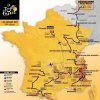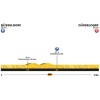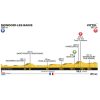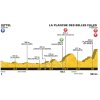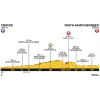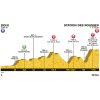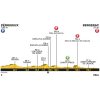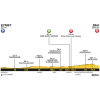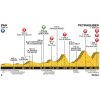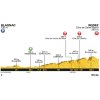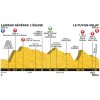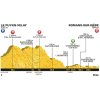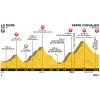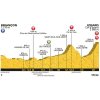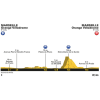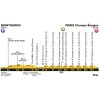Stage 1 is a flat individual time trial of 14 kilometres. On 2 July, the 2017 Tour France bids Düsseldorf goodbye with the 2nd stage, which runs to a sprinter’s arrival Liège, Belgium. Stage 3 leads from Verviers to a punchy closing climb in Longwy, while the 4th stage is set to finish on a false flat arrival in Vittel.
The race then travels further down south to the Vosges mountains for the first climbers clash. Leaving from Vittel stage 5 leads to the steep La Planche des Belles Filles – a 5.9 kilometres climb at 8.5% with steepest sectors at 20% near the top. In 2012 Froome climbed to victory on these slopes, in 2014 it was Nibali who took the flowers.
Fast men will be eyeing up stage 6, leading from Vesoul to Troyes, while the 7th stage is travelling to Nuits-Saint Georges, the famous wine walhalla in Burgundy, for yet another chance for fast finishers. The route is seeking vertical metres again in stage 8, when the riders race to Station des Rousses.
The Jura mountains are the backdrop of a harsh day in the saddle as stage 9 takes in no less than seven climbs. Col de la Biche, Grand Colombier (from its toughest side, meaning 22% grades) and Mont du Chat are all hors catégorie, while the finish is downhill in Chambery.
Week 2
The stunning Dordogne region hosts the post-rest day stage to Bergerac, after which the Tour de France travels down to the foothills of the Pyrenees in (transition) stage 11. High mountains are on the menu in stage 12 with a summit finish atop Peyragudes. In 2012, Alejandro Valverde soloed to victory at this ski station, ahead of the chasing duo Chris Froome and Bradley Wiggins.
Stage 13 is played out on Bastille Day, the 14th of July, with a short and, possibly, explosive, race to Foix. In merely 101 kilometres three cols are to be crested and expect grueling gradients of 18%. With that the Pyrenees are done.
Stage 14 travels from Blagnac to Rodez. In the 2015 Tour de France, Olympic Champion Greg Van Avermaet bested World Champion Peter Sagan in Rodez in exactly the same finale. The next day, stage 15 is played out on a route to Le Puy-en-Velay that’s tailor made for attackers.
Week 3
Following the second rest day, the 16th stage travels to Romans-sur-Isère and then the Alps ‘usher in’ the peloton. Stage 17 takes in the 2,642 metres Galibier to close with a 28 kilometres descent to ski resort Serre Chevalier, while stage 18 offers the last summit finish against the dramatic backdrop of the Col d’Izoard at 2,360 metres.
Rather surprisingly, the 2017 Tour de France will not see any high mountains in the closing weekend. In stead, stage 19 travels from Embrun to Salon-de-Provence, offering chances for fast finishers or attackers, while stage 20 is a 22.5 kilometres individual time trial in Marseille in the deep south of France.
Obviously, the last stage will finish on the Champs-Elysees in Paris.
Tour de France 2017: Route maps, height profiles, and more
Click on the images to zoom

